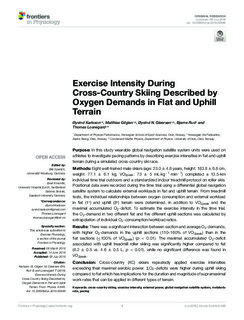| dc.contributor.author | Karlsson, Øyvind | |
| dc.contributor.author | Gilgien, Matthias | |
| dc.contributor.author | Gløersen, Øyvind Nøstdahl | |
| dc.contributor.author | Rud, Bjarne | |
| dc.contributor.author | Losnegard, Thomas | |
| dc.date.accessioned | 2019-01-04T10:08:32Z | |
| dc.date.available | 2019-01-04T10:08:32Z | |
| dc.date.created | 2018-10-10T11:33:53Z | |
| dc.date.issued | 2018 | |
| dc.identifier.citation | Frontiers in Physiology. 2018, 9, 846. | |
| dc.identifier.issn | 1664-042X | |
| dc.identifier.uri | http://hdl.handle.net/11250/2579150 | |
| dc.description.abstract | Purpose: In this study wearable global navigation satellite system units were used on athletes to investigate pacing patterns by describing exercise intensities in flat and uphill terrain during a simulated cross-country ski race. Methods: Eight well-trained male skiers (age: 23.0 ± 4.8 years, height: 183.8 ± 6.8 cm, weight: 77.1 ± 6.1 kg, VO2peak: 73 ± 5 mL⋅kg-1⋅min-1) completed a 13.5-km individual time trial outdoors and a standardized indoor treadmill protocol on roller skis. Positional data were recorded during the time trial using a differential global navigation satellite system to calculate external workloads in flat and uphill terrain. From treadmill tests, the individual relationships between oxygen consumption and external workload in flat (1°) and uphill (8°) terrain were determined, in addition to VO2peak and the maximal accumulated O2-deficit. To estimate the exercise intensity in the time trial, the O2-demand in two different flat and five different uphill sections was calculated by extrapolation of individual O2-consumption/workload ratios. Results: There was a significant interaction between section and average O2-demands, with higher O2-demands in the uphill sections (110–160% of VO2peak) than in the flat sections (≤100% of VO2peak) (p < 0.01). The maximal accumulated O2-deficit associated with uphill treadmill roller skiing was significantly higher compared to flat (6.2 ± 0.5 vs. 4.6 ± 0.5 L, p < 0.01), while no significant difference was found in VO2peak. Conclusion: Cross-country (XC) skiers repeatedly applied exercise intensities exceeding their maximal aerobic power. ΣO2-deficits were higher during uphill skiing compared to flat which has implications for the duration and magnitude of supramaximal work rates that can be applied in different types of terrain. | |
| dc.language.iso | eng | |
| dc.subject | cross-country skiing | |
| dc.subject | exercise intensity | |
| dc.subject | external power | |
| dc.subject | global navigation satellite system | |
| dc.subject | metabolic rate | |
| dc.subject | pacing | |
| dc.title | Exercise intensity during cross-country skiing described by oxygen demands in flat and uphill terrain | |
| dc.type | Peer reviewed | |
| dc.type | Journal article | |
| dc.description.version | publishedVersion | |
| dc.rights.holder | © 2018 Karlsson, Gilgien, Gløersen, Rud and Losnegard. This is an open-access article distributed under the terms of the Creative Commons Attribution License (CC BY). The use, distribution or reproduction in other forums is permitted, provided the original author(s) and the copyright owner(s) are credited and that the original publication in this journal is cited, in accordance with accepted academic practice. No use, distribution or reproduction is permitted which does not comply with these terms. | |
| dc.source.pagenumber | 12 | |
| dc.source.volume | 9 | |
| dc.source.journal | Frontiers in Physiology | |
| dc.identifier.doi | 10.3389/fphys.2018.00846 | |
| dc.identifier.cristin | 1619307 | |
| dc.description.localcode | Seksjon for fysisk prestasjonsevne / Department of Physical Performance | |
| cristin.unitcode | 150,31,0,0 | |
| cristin.unitname | Seksjon for fysisk prestasjonsevne | |
| cristin.ispublished | true | |
| cristin.fulltext | original | |
| cristin.qualitycode | 1 | |
